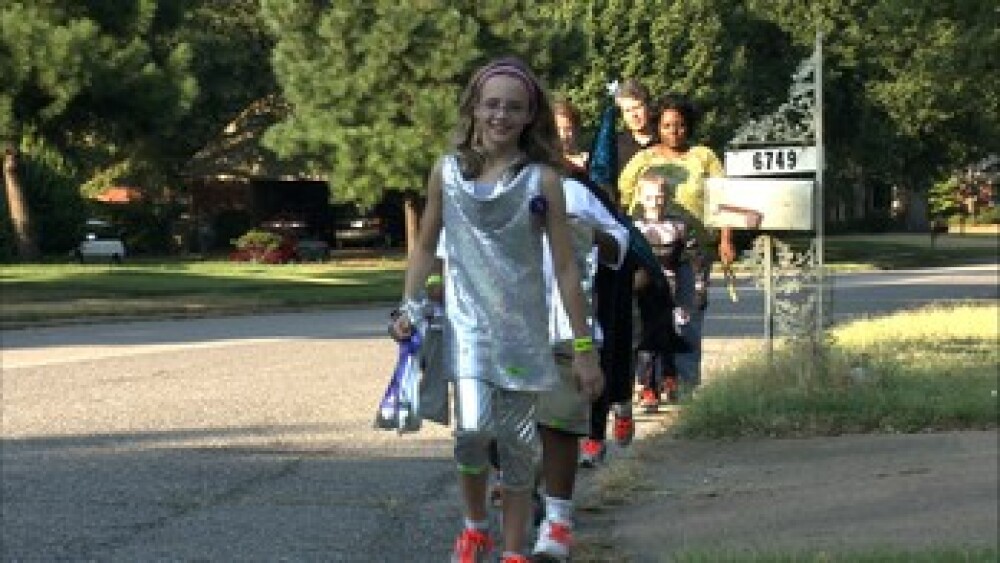Washington, D.C. – On a potentially dangerous night of the year for child pedestrians, Safe Kids USA urges parents to prepare children to act safely and drivers to take extra precautions. On average, twice as many kids are killed while walking on Halloween compared to other days of the year.
“Kids need proper safety instruction before they go out trick-or-treating,” says Moira Donahue, Safe Kids USA Director of pedestrian safety programs. “Many kids will be out trick-or-treating while it is dark and thus more difficult for drivers to see them. There are several simple and effective behaviors that parents can share with kids to help reduce their risk or injury. For example, children younger than age 12 should not be alone crossing streets on this night without an adult. If older kids are mature enough to go trick-or-treating without adult supervision, parents should make sure they go in a group and stick to a predetermined route with good lighting.”
In preparation for Halloween, 150 Safe Kids coalitions across the country will team up with Walk This Way program sponsor FedEx to provide kids with reflective materials to promote visibility, including trick-or-treat bags and zipper tags that can be attached to costumes, as well as important safety information for children, parents, and drivers.
Drivers need to be extra alert as there will be more children on the streets and sidewalks – and may also be focused on gathering candy and the excitement of the holiday. “Safe Kids and FedEx urge drivers to slow down on neighborhood roads to make Halloween more enjoyable for everyone, but also to help save lives,” added Donahue.
Top safety tips Safe Kids USA recommends for parents:
- Cross the street safely at corners, using traffic signals and crosswalks. Look left, right and left again when crossing and keep looking as you cross. Walk, don’t run, across the street.
- Walk on sidewalks or paths. If there are no sidewalks, walk facing traffic as far to the left as possible. Children should walk on direct routes with the fewest street crossings.
- Slow down and stay alert - watch out for cars that are turning or backing up and never dart out into the street or cross in between parked cars.
- Costumes can be both creative and safe. Decorate costumes and bags with reflective tape or stickers and, if possible, choose light colors. Masks can obstruct a child’s vision, so choose non-toxic face paint and make-up whenever possible instead. Have kids carry glow sticks or flashlights in order to see better, as well as be seen by drivers.
Top safety tips Safe Kids USA and FedEx recommend for drivers:
- Slow down in residential neighborhoods and school zones. Remember that popular trick-or-treating hours are during the typical period of 5:30 to 9:30 p.m.
- Be especially alert and take extra time to look for kids at intersections, on medians and on curbs. Children are excited on Halloween and may move in unpredictable ways.
- Slowly and carefully enter and exit driveways and alleys.
- Reduce any distractions inside your car, such as talking on the phone or eating, so you can concentrate on the road and your surroundings.
While pedestrian safety is a main concern on Halloween, parents and kids should also be careful when dealing with candy. “While kids never want to wait to dive into their candy, it is best to check sweets for signs of tampering before children are allowed to eat them,” says Donahue. “Remind children to only eat treats in original and unopened wrappers.”
For more tips on how to help kids become safer pedestrians on Halloween, as well as throughout the year, visit www. safekids.org
In 1999, Safe Kids Worldwide and program sponsor FedEx created the Safe Kids Walk This Way program in the United States to teach safe behaviors to motorists and child pedestrians and create safer, more walkable communities. Every day, more than 75,000 FedEx vehicles are on the road, sharing the streets with pedestrians, fueling the company’s dedication to pedestrian safety and sharing the lessons of safe driving that FedEx has learned over the past 35 years. Over the past 11 years, the program has expanded to include Brazil, Canada, China, India, South Korea, Thailand, Vietnam, and the Philippines where it has educated more than 4 million children.
